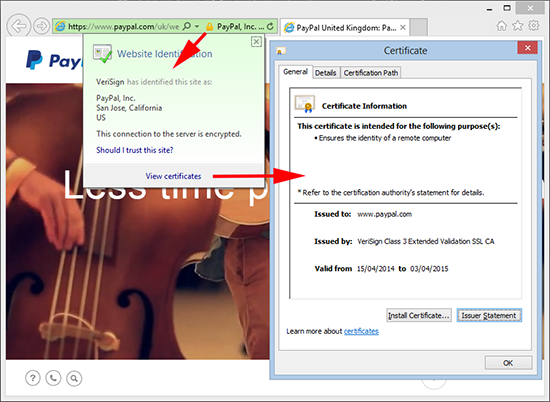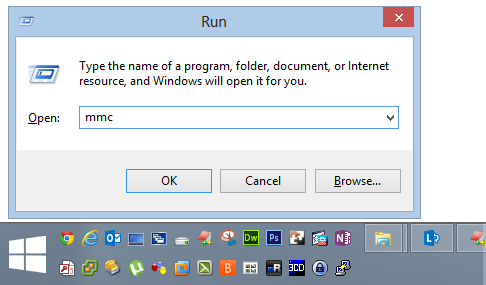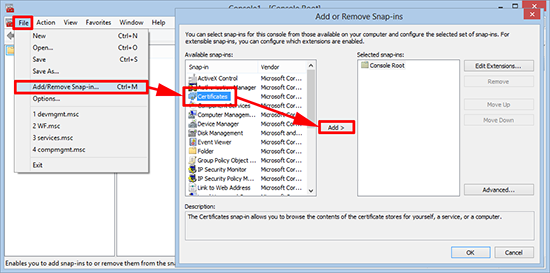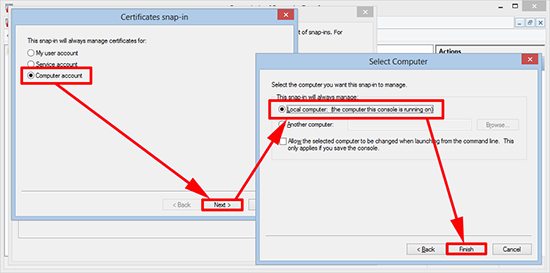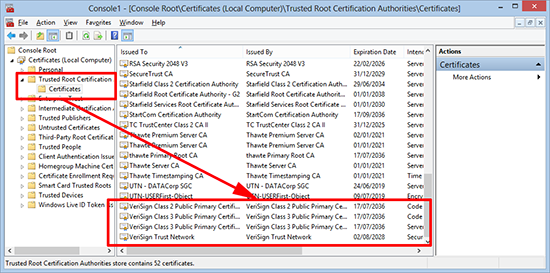KB ID 0000994
Problem
While browsing to a website with an https:// address you may come across the following error;
There is a problem with this website’s security certificate.
The security certificate presented by this website was not issued by a trusted certificate authority
and/or
The security certificate presented by this website was issued for a different website address.
Security certificate problems may indicate an attempt to fool you or intercept data you send to the server.
We recommend that you close this webpage and do not continue to this Web site.
Solution
Before you proceed: Most of the time, if you see this error a LOT, the date and time are probably set incorrectly on your computer.
This may look like a very scary error and the default action, (from the little green tick option) is NOT to proceed. But let’s look at this error sensibly. If you are on a website and you have your credit card out ready to buy something, STOP! Or you are about to enter some personal details into something then again STOP!
However if you are going to a website that your IT department has told you to go to for something (email access, or a corporate website, etc) then click the RED option, Continue to this website (not recommended).
Why are you seeing this error?
Well it’s to do with the digital certificate this website is presenting to your browser. If you ever shopped online you may have been told to look for the small padlock to make sure the site is secure.
That’s because that website is presenting you with a certificate and you ‘TRUST’ that certificate. If there was a problem with the certificate, and you didn’t trust it you would be presented with the error above.
OK So What Is a Certificate?
As far as web browsing is concerned a Digital Certificate does two things;
1. Encryption: It makes sure the information exchanged between your browser, and the server you are talking to is encrypted. This will happen if you trust the certificate or not.
2. Identity: It is used to prove, that the server you are talking to is who they say they are.
The error you are seeing is related to Identity, this DOES NOT necessarily mean the site is a fake, (but if your unsure let’s tread carefully). On the original error above it’s telling us two things;
The security certificate presented by this website was not issued by a trusted certificate authority
This means your computer does not trust the CA (Certification Authority) that created and issued this certificate. Anyone can setup a CA, (have a search on this site I’ve set them up for Exchange Email server VPNs and a ton of other reasons). These certificates are usually referred to as ‘Self Signed’. So if I (or anyone else) sets up a CA, and issues a certificate your browser will not trust it. Without a lengthy and boring description of how PKI works, you trust every CA that you have a ‘Trusted CA Root Certificate’ for. Once you have this you will trust every certificate issued by that CA.
To prove it let’s inspect the PayPal example above, and take a look at the certificate it’s presenting.
This certificate is trusted because;
1. Issued to: This name MUST match the URL you typed in the browser.*
2. Issued By: The people who signed and issued it, we trust (VeriSign).
3. Valid From: It is in date, (certificates expire). So if the date and time are very wrong on your computer, you will see loads of these errors!
*Note: It is possible to add more names to a certificate in another section called Subject Alternative Name (SAN), but these are NOT generally used for web sites.
So Who Do We Trust?
Your PC comes ‘pre-loaded’ with a bunch of trusted CA certificates, which get updated and renewed periodically. If you want to see them do the following;
Note: You need to be a computer administrator to do this. If you are NOT, then in IE Tools > Internet Options > Content > Certificates > Trusted Root Certification Authorities. You will see the same thing.
1. Windows Key +R > mmc {Enter}.
2. File > Add/Remove Snap-in > Certificates > Add.
3. Computer Account > Next > Local Computer > Finish > OK.
4. Expand Certificates (Local Computer) > Trusted Root Certificates > Certificates > Down near the bottom you while see the VeriSign CA certificates that you trust.
To Summarise, The PayPal website works (without an error) because;
1. You Trust the CA that issued its certificate.
2. The ‘Name’ on the certificate matches the URL you typed in the browser. If it didn’t we would see, (as in our first error).
The security certificate presented by this website was issued for a different website address.
3. The certificate that the website presents is in date.
If any of these things were not correct you would see the error ‘There is a problem with this website’s security certificate’.
Related Articles, References, Credits, or External Links
NA



